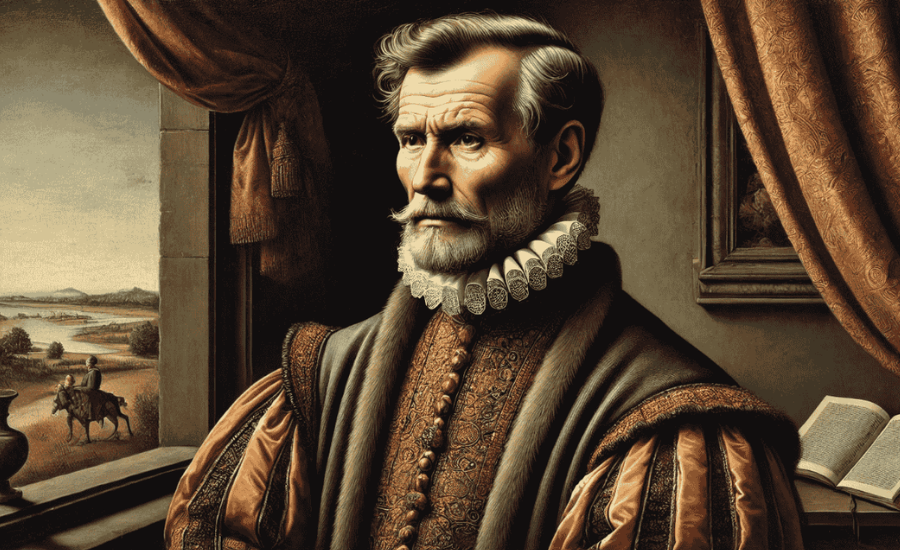The 1555 portrait of Heinrich Servais stands as a significant artifact from the German Renaissance, offering a visual entry point into an era of cultural transformation. Born in the same year as the painting, Heinrich Servais’s image transcends mere portraiture to encapsulate his profound impact on Germany’s intellectual, artistic, and social landscapes.
Historical Context: The Significance Of Heinrich Servais’s 1555 Portrait
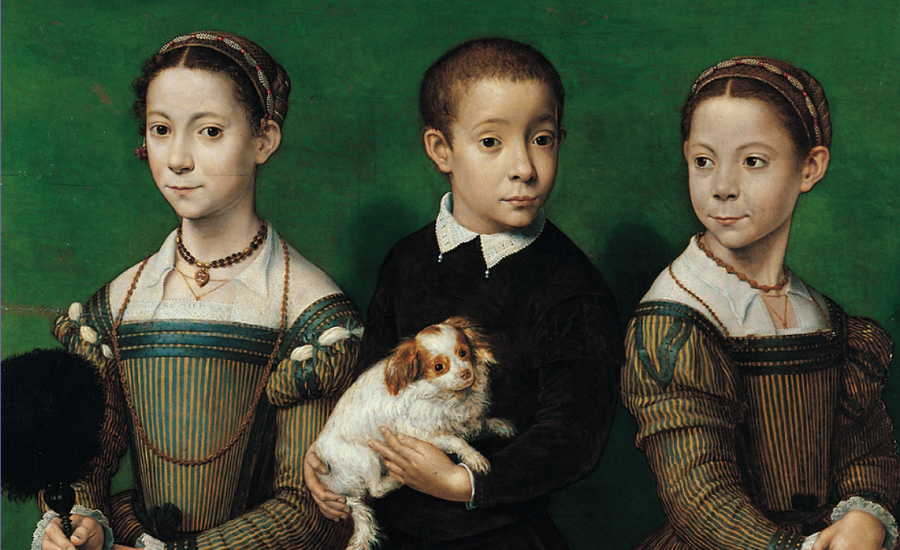
Heinrich Servais’s 1555 portrait is much more than a visual representation of an individual; it stands as an important historical artifact that reflects the cultural and intellectual shifts occurring in 16th-century Germany. The Renaissance, a period of profound transformation across Europe, was characterized by a renewed interest in classical knowledge, advancements in art, and the beginnings of modern philosophy. During this time of reformation and enlightenment, Servais emerged as a significant figure, influencing the intellectual and cultural landscape of his society. His portrait offers valuable insights into both his personal character and the broader societal movements that shaped Germany’s Renaissance period.
The Renaissance In Germany: A Time Of Change And Growth
The Renaissance period was a transformative era marked by intellectual, artistic, and scientific advancements. In Germany, as elsewhere in Europe, the period saw the decline of medieval feudalism and the rise of new ideas that challenged traditional authority. The spread of Humanism, the movement emphasizing the value of individual experience and rational thought, influenced many aspects of life, from art to governance. The Renaissance was also a time of significant religious change, with the Protestant Reformation reshaping the religious and political landscape of the German states. Heinrich Servais was part of this wave of intellectual growth, and his contributions helped steer the course of these significant transformations.
Servais’s portrait acts as a snapshot of the period, reflecting the intellectual curiosity and social mobility that defined the Renaissance. The carefully crafted portrait invites viewers to consider not just the man himself, but the broader cultural currents in which he was immersed. It serves as a bridge to understanding how individuals like Servais played a key role in shaping the intellectual and artistic developments of the time.
Heinrich Servais As A Key Figure In The Renaissance
Heinrich Servais’s role during this period was one of intellectual and social influence. The 1555 portrait immortalizes his contributions to the cultural life of Germany, highlighting his engagement with key ideas of the Renaissance. As a thinker and reformer, he was involved in shaping educational initiatives and philosophical thought that were central to the growth of Germany’s intellectual elite. The portrait reflects his stature within these circles, as well as his alignment with the ideals of the Renaissance, including the belief in the power of education, the value of human reason, and the quest for personal and societal betterment.
In this way, Servais’s portrait is not simply a representation of a man, but also a reflection of the social role and intellectual contributions he made. Through this artwork, we understand how individuals within this period of history were not only responding to, but actively shaping the cultural, political, and philosophical movements around them.
The Role Of Art In Reflecting And Shaping Society
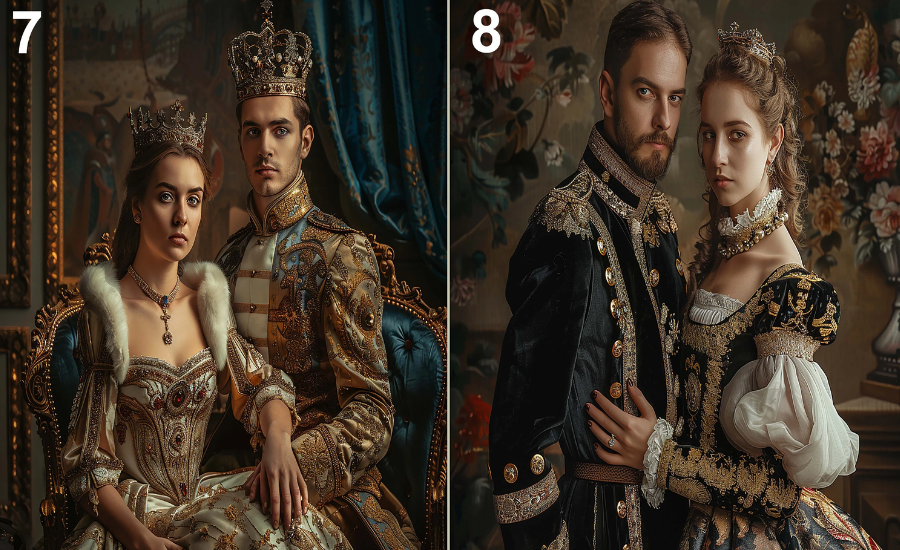
The 1555 portrait of Heinrich Servais is a prime example of how art during the Renaissance went beyond aesthetic appeal to serve as a tool for intellectual and cultural expression. Renaissance artists sought to convey more than just the outward appearance of their subjects; they aimed to capture the inner life, intellectual presence, and social significance of their subjects. Through the careful use of light, shadow, and detail, the artist of Servais’s portrait was able to emphasize his thoughtful expression, signaling his intellectual depth and engagement with the issues of his time.
The portrayal of Heinrich Servais in this portrait exemplifies the Renaissance view of the individual as a critical thinker and active participant in societal change. By embedding his likeness within the visual language of the Renaissance, the portrait underscores the growing importance of personal identity and intellectual authority during this period. It highlights how art became an essential medium through which the values of the time were communicated, and how individuals like Servais used their influence to challenge and transform the established norms of their society.
Heinrich Servais’s Contributions To Education And Philosophy
Heinrich Servais’s impact on education and philosophy is perhaps one of his most enduring legacies. The Renaissance was a time when the quest for knowledge was central to societal progress, and Servais’s role as an advocate for education helped shape the intellectual framework of 16th-century Germany. Through his participation in local governance and philosophical circles, Servais contributed to the development of policies and ideas that emphasized the importance of learning, critical thought, and intellectual engagement.
His portrait memorializes his intellectual stature and underscores the significance of his educational reforms. By engaging with the Renaissance ideals of humanism and individual inquiry, Heinrich Servais helped foster an environment where knowledge could flourish and be disseminated to a broader population. This educational legacy, symbolized by his portrait, continues to be an important aspect of his lasting influence on German society.
The Intersection Of Personal Identity And Societal Movements
Heinrich Servais’s 1555 portrait captures not just his personal identity but also serves as a symbolic representation of the societal changes occurring around him. As a man deeply involved in intellectual and civic affairs, Servais’s likeness transcends mere depiction; it is an emblem of the societal shifts of the time. Through the artwork, we are able to see how personal identity and broader cultural movements intersect, with Servais embodying the Renaissance’s focus on individualism, education, and the pursuit of knowledge.
His portrait stands as a reminder of the significant role individuals played in shaping the course of history. It is a visual representation of the power of the human intellect to influence culture, society, and politics during a time of profound change. By preserving his likeness, this portrait immortalizes both Heinrich Servais as a key figure in German history and the larger intellectual and cultural currents that defined the Renaissance period.
Who Was Heinrich Servais? A Deeper Understanding Through His Portrait
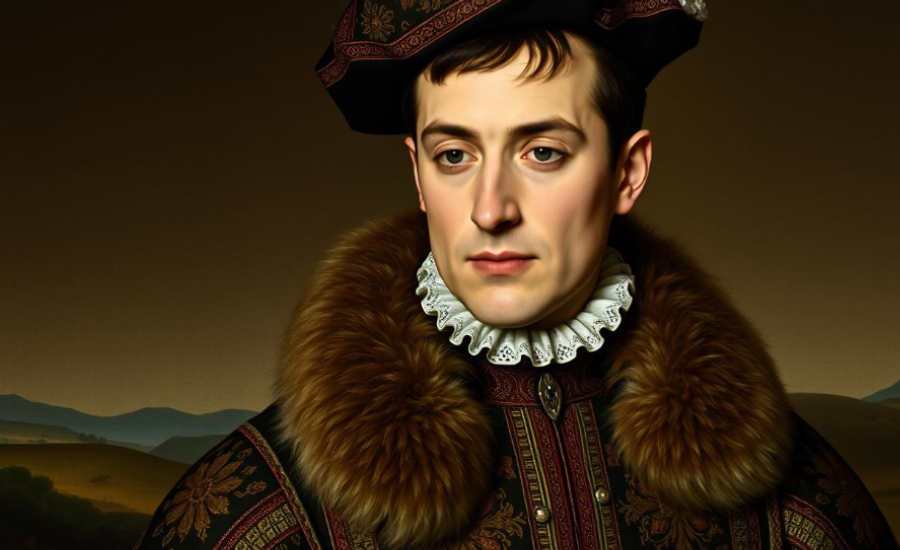
Born in 1555, Heinrich Servais was a figure whose life and works were deeply intertwined with the intellectual renaissance unfolding in Europe. He contributed significantly to education, civic administration, and philosophical thought, making him an influential figure in the shaping of German society during this transformative period.
The portrait captures more than just his outward appearance; it reflects his thoughtful and contemplative nature, emblematic of the Renaissance thinkers who championed knowledge, art, and social progress. Through this image, we get a sense of Servais’s active engagement with the issues of his time, showcasing him as a man who not only thought deeply but also worked diligently to improve the world around him.
The Renaissance In Germany: Insights From Heinrich Servais’s Portrait
The 1555 portrait of Heinrich Servais offers a glimpse into the intellectual and artistic atmosphere of Renaissance Germany. This era was marked by a renewed focus on humanism, exploration, and education. Art was a medium for communicating complex ideas, and Servais’s portrait reflects this ideal, serving not only as a representation of an individual but as a symbol of the Renaissance values that emphasized both creativity and learning.
By examining this portrait, we not only gain insight into Heinrich Servais’s contributions but also into the cultural shifts occurring in Germany during his lifetime. The portrait stands as a testament to the merging of intellectual growth and artistic expression, defining characteristics of the Renaissance period.
Artistic Elements Of The 1555 Portrait: A Reflection Of Renaissance Mastery
The 1555 portrait of Heinrich Servais is an exquisite example of Renaissance artistry. The careful application of light and shadow, along with the artist’s attention to detail, creates a vivid and lifelike depiction of the subject. The use of realistic textures, particularly in the rendering of Servais’s clothing and expression, showcases the technical skill of the period’s artists.
The simplicity yet elegance of the background draws attention to Heinrich’s persona, emphasizing his intellectual stature. The painting is not just an aesthetic achievement; it serves as a vehicle for conveying the values of the Renaissance, including the pursuit of knowledge, artistic expression, and social responsibility.
Heinrich Servais’s Role In Shaping German Society
Heinrich Servais was more than just an academic; he played a pivotal role in the cultural and intellectual life of 16th-century Germany. His advocacy for education and his involvement in local governance helped foster a climate of intellectual exploration and social progress. The 1555 portrait stands as a visual testament to his significant influence, offering us a glimpse into a man who championed learning and innovation in an era of change.
Through his active participation in reforming education and advancing social policy, Heinrich Servais helped lay the groundwork for a more enlightened Germany. His legacy, immortalized in this portrait, reminds us of the power of individuals to shape society for the better.
The Enduring Legacy Of Heinrich Servais As Reflected In His 1555 Portrait

The 1555 portrait of Heinrich Servais goes beyond being a simple artistic rendering; it serves as a timeless representation of his enduring legacy. This powerful image not only memorializes his physical likeness but also encapsulates the depth of his contributions to the cultural, intellectual, and social development of his community and country. Through his active involvement in education, governance, and philosophy, Heinrich Servais left an indelible mark on the trajectory of 16th-century Germany. His portrait stands as a visual testament to his commitment to intellectual progress, social reform, and the cultivation of values that continue to resonate in the present day.
Servais’s Contributions To Education: Shaping Future Generations
One of Heinrich Servais’s most significant contributions was to the field of education, which was central to the Renaissance humanist movement. At a time when the foundations of modern education were being laid, Servais was a prominent advocate for learning and the spread of knowledge. His efforts to reform educational practices were in line with the broader Renaissance ideals that placed emphasis on human potential, reason, and the importance of critical thinking.
His role in establishing or enhancing educational institutions and promoting intellectual inquiry helped lay the groundwork for future generations of thinkers, scholars, and educators. Through his advocacy, Heinrich Servais helped ensure that education was accessible, structured, and aligned with the intellectual currents of the Renaissance. The 1555 portrait encapsulates his intellectual fervor, reminding us of the transformative power of education and its ability to shape society for the better.
The Role Of Governance And Political Engagement In Servais’s Legacy
In addition to his contributions to education, Heinrich Servais played a pivotal role in governance and political reform during his time. As an active participant in the political life of his community, he sought to improve the systems of governance and policymaking, guided by principles of fairness, justice, and societal betterment. His influence in shaping local political structures reflected the increasing importance of civic engagement and political reform during the Renaissance period.
Servais’s involvement in governance was rooted in his belief that intellectual engagement and moral responsibility went hand in hand. His leadership exemplified the Renaissance ideal of the enlightened ruler or citizen—someone who was not only concerned with personal success but also with the betterment of society. The portrait captures the gravitas of his political stature, symbolizing his deep connection to the evolving political landscape of 16th-century Germany. It is a reminder of how political engagement can serve as a force for positive change and progress.
Philosophical Thought: Heinrich Servais As An Intellectual Leader
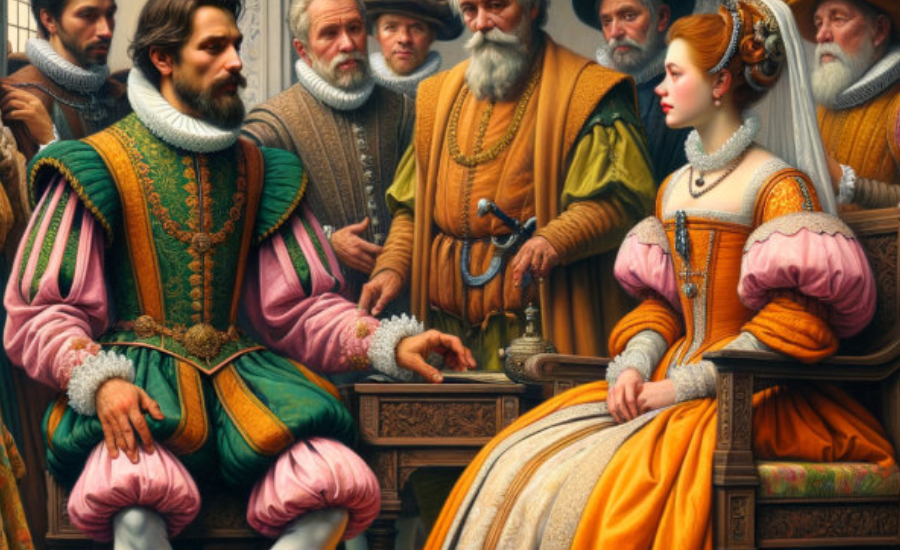
Heinrich Servais was also a key figure in the philosophical circles of his time. Drawing from the Renaissance’s renewed interest in classical ideas, Servais engaged with the most pressing philosophical questions of his era. His intellectual pursuits were centered on advancing the humanist vision of personal development through reason and education, emphasizing the power of the individual to shape their own destiny within a greater social context.
As an intellectual leader, Servais helped steer the philosophical debates of the time, offering new perspectives on the relationship between the individual and society. His contributions to the development of Renaissance philosophy were grounded in the belief that knowledge and reason could be used to challenge outdated systems and encourage a more just and enlightened society. Through the lens of his 1555 portrait, we can see his intellectual depth and his commitment to the ideals of philosophical inquiry, which continue to influence contemporary thought.
Art As A Reflection Of Enduring Values
Art, particularly during the Renaissance, was often used not just to document a person’s appearance, but to symbolize their ideas, contributions, and the broader cultural values they represented. Heinrich Servais’s portrait is a perfect example of how art transcends its immediate context to become a lasting symbol of a person’s legacy. The artist’s careful attention to detail, facial expression, and composition serves to immortalize Servais’s intellectual and social contributions in a way that continues to resonate with viewers today.
The portrayal of Servais in the 1555 painting reflects his engagement with the intellectual and cultural movements of the time. The portrait serves as an iconic representation of a man who was deeply involved in the academic, political, and philosophical spheres of his society. By capturing not just his physical likeness, but his intellectual presence and moral integrity, the painting serves as a powerful reminder of the values that defined the Renaissance—values that continue to be relevant and meaningful in the modern world.
The Legacy Of Knowledge And Cultural Growth
Heinrich Servais’s 1555 portrait is not just a static representation of a historical figure; it is a living artifact that continues to impart valuable lessons about the importance of knowledge, education, and cultural growth. As we view the portrait today, we are reminded of how individuals like Servais have shaped the course of history through their intellectual pursuits and social engagement. His legacy is not just confined to the 16th century but continues to influence contemporary thought on education, governance, and philosophy.
The enduring message of Servais’s life and work, encapsulated in this portrait, is the vital role that knowledge and cultural growth play in the advancement of society. His commitment to learning and progress serves as an inspiration for future generations to engage with these same values. The portrait, by preserving his likeness and immortalizing his contributions, ensures that Heinrich Servais’s impact on education, philosophy, and society is not forgotten but continues to inspire those who seek to make a meaningful difference in the world.
Art As A Timeless Bridge To The Past

In addition to serving as a historical document, Heinrich Servais’s portrait functions as a bridge between the past and the present. The painting’s ability to transcend time and offer viewers a glimpse into the mind and character of a man who lived over 450 years ago is a testament to the enduring power of art. Through this image, we can connect with the intellectual and social ideals of the Renaissance and reflect on how these values continue to shape the world we live in today.
By engaging with this portrait, contemporary viewers can reflect on the importance of preserving the legacies of great thinkers like Heinrich Servais. The portrait serves as a reminder that art, in its many forms, has the ability to preserve not just historical moments, but the intellectual and cultural currents that define those moments. Through this lens, we are reminded of how art can be a powerful vehicle for understanding the past and inspiring progress in the future.
Facts About Heinrich Servais And His 1555 Portrait
- Heinrich Servais Was Born in 1555
Heinrich Servais was born in the year 1555, making his life coincide with a period of significant cultural and intellectual change in Europe. The 16th century, especially in Germany, was marked by the Renaissance, the Reformation, and the early stages of the Enlightenment. - Heinrich Servais Was an Influential Figure in Education
A key advocate for educational reform, Servais played a pivotal role in advancing intellectual inquiry and the spread of humanist ideas. He contributed to the development of educational institutions and promoted the importance of knowledge for societal progress. - The 1555 Portrait Was Commissioned During His Lifetime
The portrait, which was painted in 1555, serves as a visual document of Heinrich Servais’s significance as an intellectual leader. It was created during his lifetime and is one of the most enduring representations of him. - Heinrich Servais Was Involved in Governance and Political Reforms
Beyond education, Servais made his mark on politics and local governance, advocating for just leadership and systems that would benefit the wider community. His involvement in political reform reflects the Renaissance ideal of enlightened governance. - The 1555 Portrait Reflects the Renaissance Art Movement
The portrait was created during the height of the Renaissance, which is known for its advancements in realism, use of light and shadow, and detailed representations of individuals. The artwork of Heinrich Servais displays these characteristics, capturing his dignified expression and reflective personality. - The 1555 Portrait Represents the Philosophical Spirit of the Renaissance
Heinrich Servais’s portrait not only represents his likeness but also encapsulates the intellectual spirit of the Renaissance. During this time, thinkers placed a high value on the pursuit of knowledge, individualism, and the study of classical texts—values that Servais himself embodied.
FAQs
Q: Who was Heinrich Servais?
A: Heinrich Servais was a prominent intellectual, educator, and philosopher in 16th-century Germany, known for his contributions to education and governance during the Renaissance.
Q: When was the 1555 portrait of Heinrich Servais painted?
A: The portrait was created in 1555, during Heinrich Servais’s lifetime, capturing his likeness and reflecting the intellectual spirit of the Renaissance.
Q: What is the significance of Heinrich Servais’s portrait?
A: The portrait serves as a historical document and symbol of his intellectual and cultural contributions, particularly in the fields of education and philosophy.
Q: What does the portrait reveal about the Renaissance?
A: It showcases the Renaissance values of humanism, intellectual growth, and artistic realism, highlighting Heinrich Servais’s role in advancing these ideals.
Q: How does Heinrich Servais’s legacy live on today?
A: Through his 1555 portrait, Heinrich Servais’s contributions to education, social progress, and governance continue to inspire modern thought and cultural development.
Conclusion
Heinrich Servais’s 1555 portrait stands as both an artistic and intellectual monument, capturing the essence of a man whose contributions shaped the course of 16th-century German society. Through his involvement in education, governance, and philosophy, Servais left a lasting legacy that continues to influence contemporary thought on the importance of knowledge, social progress, and intellectual engagement. The portrait, by immortalizing his likeness, also immortalizes the values that defined his life—values that remain as relevant today as they were in the Renaissance. As we reflect on this image, we are reminded of the profound impact that individuals can have on their societies, and how their legacies can transcend time through the power of art and intellectual contributions.
Stay informed with the latest news and updates on Magazinereleased.com
